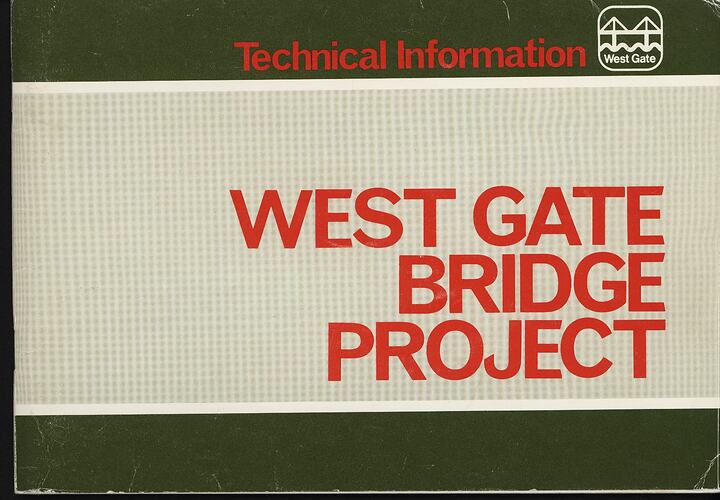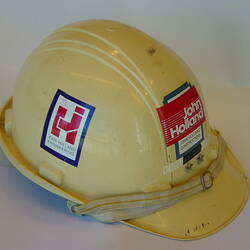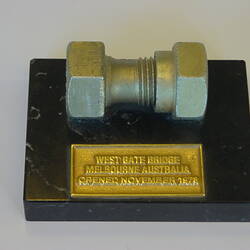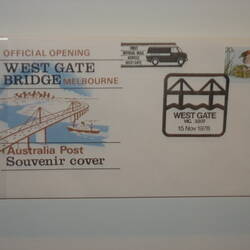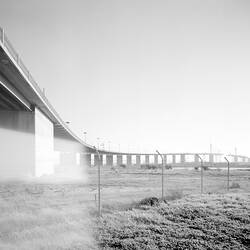Summary
Information booklet or brochure describing the technical features of the West Gate Bridge, Melbourne, built between 1967 and 1978, including a list of principal design consultants and construction contractors involved both prior to and after the collapse in October 1970. Published by the Lower Yarra Crossing Authority, between 1971 and 1974.
Description of Content
Information booklet or brochure describing the technical features of the West Gate Bridge, Melbourne, built between 1967 and 1978, including a list of principal design consultants and construction contractors involved both prior to and after the collapse in October 1970. Published by the Lower Yarra Crossing Authority, circa 1971.
Physical Description
210 mm x 147 mm x 5 mm, staple-bound, 54 pages, with 14 figures and technical diagrams, including artist's depiction of completed bridge. Printed in black & white main text with two-colour red and olive green cover.
Significance
This booklet provides a definitive technical description of the West Gate Bridge published by the authority which managed its construction.
Built between 1968 and 1978, the Westgate Bridge has become an integral part of Melbourne's freeway network and a vital east-west transport link that connecting Melbourne's western suburbs and the Princes Freeway route to Geelong and beyond to the centre of Melbourne. Designed to replace the Williamstown Ferry that had operated across the lower Yarra between Fisherman's Bend and Newport since 1931, it was constructed by the Lower Yarra Crossing Authority and initialled opened as a tollway - the first 'user pays' road in Melbourne for over a century.
Since it first began to rise above the mudflats of the lower Yarra, the West Gate Bridge has become a key local landmark which Melburnians quickly took to heart and it remains the city's best recognised international engineering landmark. Towering high above the river flats with its sweeping approach spans and 102-metre high twin cable-stay towers, it is Victoria's highest and second-longest bridge, with an overall length of 2,582 metres, including approach spans. Its innovative design was of international significance, at the time, with the world's longest cable-stayed steel girder span.
On 15 October 1970, the West Gate Bridge made international headlines when at 11.50 am the partially completed 367-ft (112 m) box girder span between piers 10 and 11 collapsed. In a matter of seconds 2,000 tonnes of steel and concrete crashed 50 metres onto the river mudflats bringing down two of the bridge piers and killing 35 workers, with 18 others seriously injured. The disaster remains Australia's worst industrial accident in terms of lives lost and became a pivotal moment in Melbourne's post-war history.
A Royal Commission appointed to investigate the disaster sat for 80 days and interviewed 52 witnesses, reporting in July 1971 with the conclusions that the failure was jointly attributable to short-comings in the original design calculations undertaken by the structural designers, Freeman Fox & Partners, of London, and to the unusual erection methods employed by the principal construction contractors, World Services & Construction, although the immediate chain of events that lead to the collapse was caused by poor communication between the designers and contractors and between the contractors their site engineers and construction foreman.
Following design alterations construction of the West Gate Bridge was finally completed in 1978 at a cost of $202 million - over eight times the original estimate. While Sydney-siders had become used to paying tools for decades to cross their Harbour Bridge, the tolls initially charged on all private & commercial vehicles (60c for cars & $2 for trucks) crossing the West Gate Bridge were unpopular with Melburnians and after just six years were abolished early in the first term of Cain Labor Government. By mid 1979, the bridge was carrying 22,000 vehicles/day.
More Information
-
Collection Names
-
Collecting Areas
-
Acquisition Information
Purchase
-
Publisher
Lower Yarra Crossing Authority, Melbourne, Greater Melbourne, Victoria, Australia, circa 1973
Organisation later became the West Gate Bridge Authority in 1974, and was subsequently absorbed into VicRoads in 1982. -
Inscriptions
Text, front cover: Technical Information West Gate/WEST GATE/BRIDGE/PROJECT.
-
Classification
-
Category
-
Discipline
-
Type of item
-
Overall Dimensions
14.7 cm (Length), 21 cm (Width)
Staple-bound, 54 pages.
-
References
See curatorial research file on 'West Gate Bridge'. Bill Hitchings, "West Gate", 1979. Report of Royal Commission into the Failure of the West gate Bridge, Victoria, C.H. Dixon, Government Printer, Melbourne, 1971. West Gate Memorial website: [Link 1]
-
Keywords
Bridge Construction, Bridge Design, Bridges, Civil Engineering, Road Transport, Souvenirs
